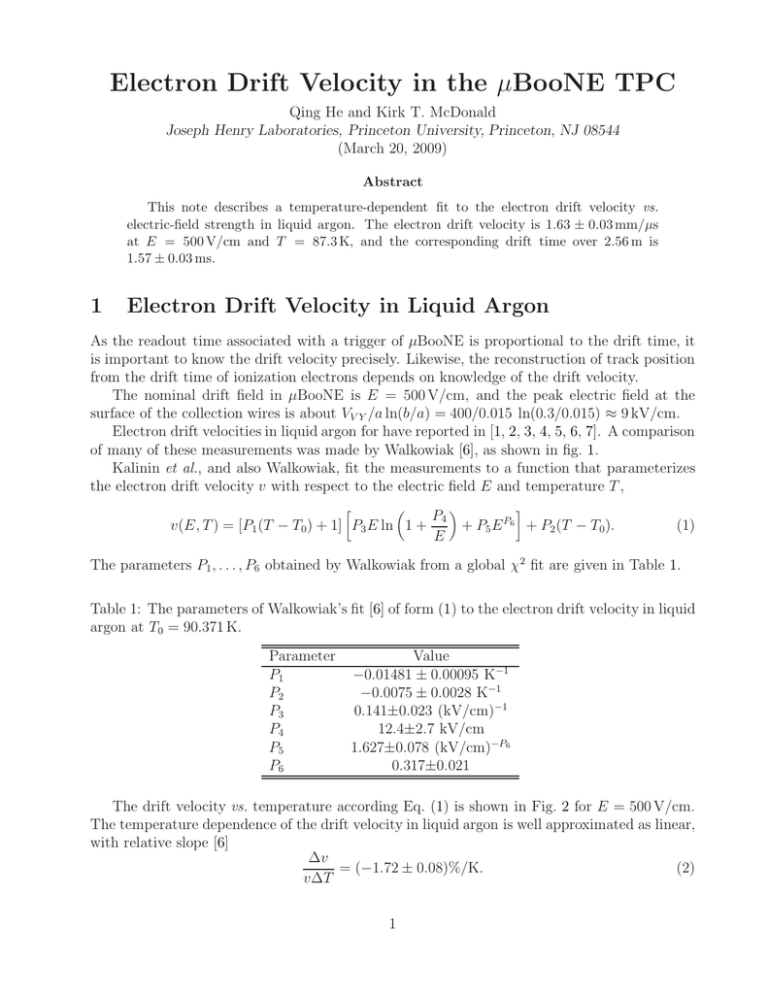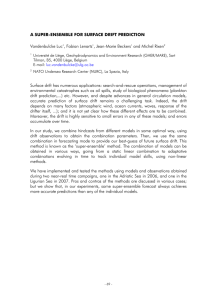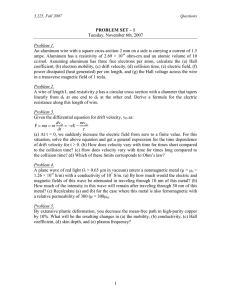Electron Drift Velocity in the μBooNE TPC
advertisement

Electron Drift Velocity in the μBooNE TPC Qing He and Kirk T. McDonald Joseph Henry Laboratories, Princeton University, Princeton, NJ 08544 (March 20, 2009) Abstract This note describes a temperature-dependent fit to the electron drift velocity vs. electric-field strength in liquid argon. The electron drift velocity is 1.63 ± 0.03 mm/µs at E = 500 V/cm and T = 87.3 K, and the corresponding drift time over 2.56 m is 1.57 ± 0.03 ms. 1 Electron Drift Velocity in Liquid Argon As the readout time associated with a trigger of μBooNE is proportional to the drift time, it is important to know the drift velocity precisely. Likewise, the reconstruction of track position from the drift time of ionization electrons depends on knowledge of the drift velocity. The nominal drift field in μBooNE is E = 500 V/cm, and the peak electric field at the surface of the collection wires is about VV Y /a ln(b/a) = 400/0.015 ln(0.3/0.015) ≈ 9 kV/cm. Electron drift velocities in liquid argon for have reported in [1, 2, 3, 4, 5, 6, 7]. A comparison of many of these measurements was made by Walkowiak [6], as shown in fig. 1. Kalinin et al., and also Walkowiak, fit the measurements to a function that parameterizes the electron drift velocity v with respect to the electric field E and temperature T , v(E, T ) = [P1 (T − T0) + 1] P3 E ln 1 + P4 + P5 E P6 + P2 (T − T0). E (1) The parameters P1 , . . . , P6 obtained by Walkowiak from a global χ2 fit are given in Table 1. Table 1: The parameters of Walkowiak’s fit [6] of form (1) to the electron drift velocity in liquid argon at T0 = 90.371 K. Parameter P1 P2 P3 P4 P5 P6 Value −0.01481 ± 0.00095 K−1 −0.0075 ± 0.0028 K−1 0.141±0.023 (kV/cm)−1 12.4±2.7 kV/cm 1.627±0.078 (kV/cm)−P6 0.317±0.021 The drift velocity vs. temperature according Eq. (1) is shown in Fig. 2 for E = 500 V/cm. The temperature dependence of the drift velocity in liquid argon is well approximated as linear, with relative slope [6] Δv = (−1.72 ± 0.08)%/K. (2) vΔT 1 Drift Velocity (mm/μs) Figure 1: Drift velocities in liquid argon reported by [6] (this measurement), by Miller et al. [2], by Yoshino et al. [3], and fits to measurements by Kalinin et al. [5]. 2 1.8 Atlas: E=0.5 kV/cm 1.6 1.4 1.2 1 86 88 90 92 94 Temperature (K) Figure 2: Electron drift velocity vs. temperature in liquid argon at E = 500 V/cm, from Eq. (1) [6]. A representative uncertainty is shown at T = 87.3 K (nominal temperature of μBooNE). 2 Drift Velocity Ratio 1.1 89 K 87.3 K 1.05 85 K 1 0.95 0.5 1 E (kV/cm) Figure 3: Ratio of the fits of form (1) to the drift velocity by Kalinin et al. [5] and [6] as a function of the electric field strength E. The fits of Kalinin et al. and of Walkowiak have somewhat different parameters, as a result of different assumptions as to the temperature T0 . However, the fitted curves are very consistent with one another, as shown in Fig. 3. Francesco Lanni made an empirical fit to the data of Miller et al. [2], taken at 85 K for liquid argon, as shown in Fig. 4. His parameterization is v(E) = 2a0 E a1 −a , 1 + ea2 E 3 (3) where E is the electric field, a0 = 1.31195, a1 = 1.87803×10−7 , a2 = 10.9707, and a3 = 0.216244. This fit has been used in some μBooNE Garfield simulations, although the measurements of Miller et al. do not agree well with those of Kalinin et al. at the same temperature. Further, because of the difference between the temperature of liquid argon of Miller et al. (85 K) and μBooNE (87.3 K), it is inappropriate to use Lanni’s fit for μBooNE A comparison of the parameterizations (1) and (3) is shown in Fig. 5. The blue dashed line represents Lanni’s parameterization, Eq. (3), at T = 85 K; the red lines represent Walkowiak’s parameterization, Eq. (1) [6], at T = 89 K (solid line), T = 87.3 K (dashed line), and T = 85 K (dotted line). Also shown is ICARUS’ measurement [7] at E = 500 V/cm and T = 89 K, which agrees well with the fit of Walkowiak at that temperature. There is a 20% difference between the blue dashed line (Lanni) and the red dotted line (Walkowiak) at E = 500 V/cm and T = 85 K. Parameterization (1) is recommended for use in future μBooNE simulations and data analysis. At the nominal operating temperature of μBooNE, T = 87.3 K, Eq. (1) predicts the drift velocity to be 1.63 ± 0.03 mm/μs at E = 500 v/cm. Of the 2.1% uncertainty reported in [6], the 3 Drift Velocity (mm/μs) Figure 4: Drift velocities in liquid argon reported by [6] (this measurement), by Miller et al. [2], by Yoshino et al. [3], and fits to measurements by Kalinin et al. [5]. 2 Atlas (89 K) Atlas (87.3 K) 1.5 Atlas (85 K) Francesco (85 K) ICARUS (89 K) 1 0.5 1 E (kV/cm) Figure 5: Electron drift velocity vs. electric field in liquid argon. Red lines: Atlas’ fit, Eq. (1) [6], at T = 89 K (solid line), T = 87.3 K (dashed line), and T = 85 K (dotted line). Blue dashed line: Lanni’s fit, Eq. (3), at 85 K. Point with error bars: ICARUS measurement [7] at E = 500 V/cm and T = 89 K. 4 systematic uncertainty dominates. For a 2.56-m drift length, the drift time is 1.57 ± 0.03 ms at E = 500 V/cm. 2 Effect of Diffusion We used Garfield [8] to simulate the drift time, with and without diffusion, with the drift velocity parameterized by Eq. (1). Diffusion was parameterized by D = D⊥ where D⊥ = 15.5 cm2 /s, as measured by [4]. Garfield uses a Monte Carlo method to simulate the diffusion. In our simulation, 200 electrons drifted from the same initial point, 2.6 m from the collection (Y) wire plane. The drift lines are shown in Fig. 6a. The drift-time distribution at the collection plane, shown in Fig. 6b, is fit by a Gaussian function with mean of 1572.4 μs, and standard deviation of 1.29 μs. Figure 6: Left: Drift lines of 200 electrons over 2.56 m of liquid argon in a Garfield simulation with diffusion. Right: Drift-time distribution for the 200 electrons in the Garfield simulation. These results agree well with the drift time of 1.57 ± 0.03 ms that is predicted in the absence of diffusion, and with the rms spread σt in drift time due to diffusion assuming a constant drift velocity v, √ 2D t 2 · 15.5 · 0.00157 σx = 1.35 μs. (4) σt = = = v v 1.63 × 105 We also used the cloud option of Garfield, which implements Eq. (4) for variable drift velocity, which method returned a drift time of 1571.8 ± 1.29 μs. The variation of drift time caused by diffusion is much smaller than that associated with the uncertainty in the drift velocity, 5 3 Summary • It is recommended to use the temperature-dependent fit (1) to drift velocity. • The nominal drift velocity in μBooNE is 1.63±0.03 mm/μs at E = 500 V/cm and T = 87.3 K. • The nominal drift time in μBooNE for a 2.56-m-wide TPC is 1.57 ± 0.03 ms. at E = 500 V/cm and T = 87.3 K • The effect of diffusion on the average drift time is negligible. References [1] D.W. Swan, Drift velocity of electrons in liquid argon, and the influence of molecular impurities, Proc. Phys. Soc. 83, 659 (1964), http://puhep1.princeton.edu/~mcdonald/examples/detectors/swan_pps_83_659_64.pdf [2] L.S. Miller, S. Howe and W.E. Spear, Charge Transport in Solid and Liquid Ar, Kr and Xe, Phys. Rev. 166, 871-877 (1968), http://puhep1.princeton.edu/~mcdonald/examples/detectors/miller_pr_166_871_68.pdf [3] K. Yoshino, U. Sowada and W.F. Schmidt, Effect of molecular solutes on the electron drift velocity of liquid Ar, Kr, and Xe, Phys. Rev. A 14, 438 (1976), http://puhep1.princeton.edu/~mcdonald/examples/detectors/yoshino_pra_14_438_76.pdf [4] E. Shibamura et al., Ratio of diffusion coefficient to mobility for electrons in liquid argon, Phys. Rev. A 20, 2547, (1979), http://puhep1.princeton.edu/~mcdonald/examples/detectors/shibamura_pra_20_2547_79.pdf [5] A.M. Kalinin et al., Temperature and Electric Field Strength Dependence of Electron Drift Velocity in Liquid Argon, ATLAS-LARG-NO-058 (12 Dec. 1996), http://puhep1.princeton.edu/~mcdonald/examples/detectors/kalinin_larg-no-058_96.pdf [6] W. Walkowiak, Drift velocity of free electrons in liquid argon, Nucl. Instr. and Meth. A 449, 288-294 (2000), http://puhep1.princeton.edu/~mcdonald/examples/detectors/walkowiak_nim_a449_288_00.pdf [7] S. Amoruso et al., Analysis of the liquid argon purity in the ICARUS T600 TPC, Nucl. Instr. and Meth. A 516, 68-79 (2004), http://puhep1.princeton.edu/~mcdonald/examples/detectors/amoruso_nim_a516_68_04.pdf [8] R. Veenhof, Garfield – simulation of gaseous detectors, Version 9 (4 Jul 2008), http://garfield.web.cern.ch/garfield/ 6



